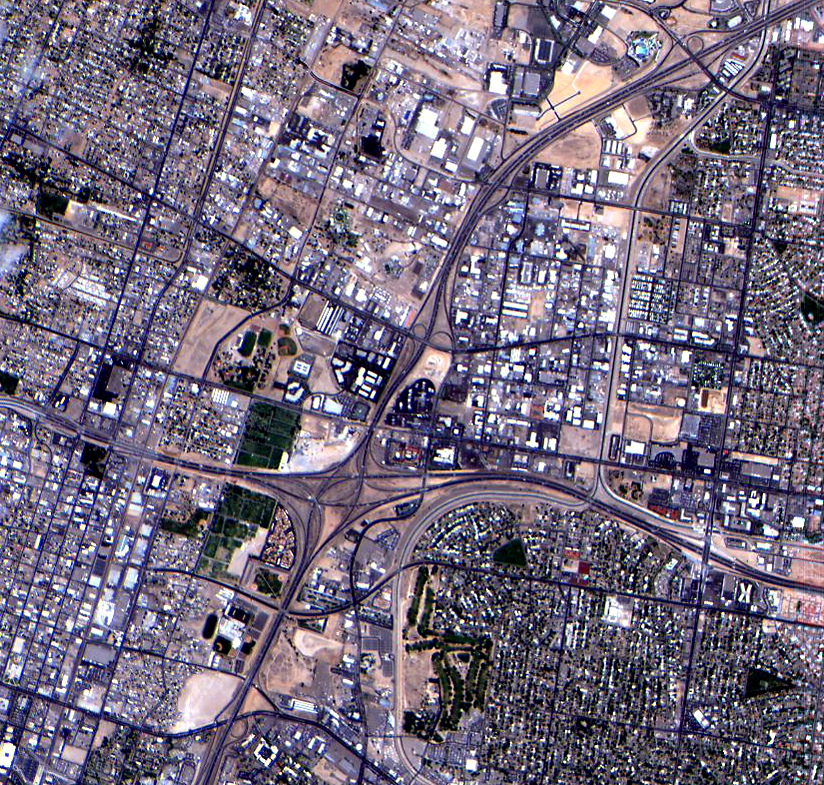
Download 300dpi JPEG image, ‘1BIGEYE.jpg’, 1.1Mb (Media are welcome to download/publish this image with related news stories.)
ALBUQUERQUE, N.M. — Sandia National Laboratories today announced that the Department of Energy’s (DOE’s) Multispectral Thermal Imager (MTI) satellite has completed on-orbit checkout and is ready to begin its research and development mission.
The Air Force Space and Missile Center’s Test and Evaluation Directorate launched the 1,300-pound satellite on March 12 aboard an Orbital Sciences Corporation Taurus rocket from Vandenberg Air Force Base (Calif.). Since then, the satellite has been undergoing normal checkout and calibration procedures.
The R&D satellite, developed by a Sandia-led government and industry team, carries an advanced ground-imaging system that very accurately measures the “brightness” of various features in 15 visible and infrared spectral bands (only three bands are visible to the human eye). The imaging instrument was assembled and tested at Sandia and calibrated at Los Alamos National Laboratory.
During the next three years MTI will collect images of volunteer ground sites located throughout the U.S. The sites will be instrumented by DOE’s Savannah River Technology Center (SRTC) and other government agencies with sensors that collect simultaneous “ground truth” data.
Researchers then will compare the satellite data with the ground truth data to develop engineering, processing, and analytic techniques that could be employed in future satellite systems to address a host of national needs, ranging from military and treaty monitoring applications to hazardous waste site characterization and climate research.
Researchers at Sandia, Los Alamos, and SRTC will focus on treaty monitoring applications, while researchers at 50 other national defense and civilian organizations involved in the project will address applications of interest to their respective agencies.
The satellite also carries a High-energy X-Ray Spectrometer (HXRS) sponsored by the National Oceanic and Atmospheric Administration’s Space Environment Center and the Czech Republic’s Astronomical Institute of the Academy of Sciences, and developed by Space Devices, Ltd. of the Czech Republic. This R&D instrument will monitor the sun to collect data needed to better understand a rare species of solar flare associated with high-energy particle storms that can endanger astronauts and damage space equipment.
MTI is a jointly funded project. DOE’s Office of Nonproliferation and National Security is the primary funding agency, responsible for satellite and ground-component development, on-orbit operations, and treaty monitoring R&D. The Department of Defense funded the launch through the Air Force Space Test Program, and additional ongoing R&D funding is being provided to individual researchers by their respective agencies.
“For DOE, the successful transition of MTI to an operational status as an R&D system is of tremendous significance,” says Sandia Senior VP for National Security and Arms Control Roger Hagengruber. “A whole new capability to investigate arms control and environmental monitoring approaches for the 21st century has been initiated. It is also a credit to the technical strength and teamwork of the DOE’s multilab team.
“For Sandia as the system engineer and integrator, it is a tremendous credit to the men and women who worked day and night in pursuit of a dream and with a conviction,” he adds. “Every piece of new data from the system is like an exciting new discovery.”
Major project participants include Sandia, Los Alamos, SRTC, the Air Force Research Laboratory, Ball Aerospace, Raytheon, and TRW.